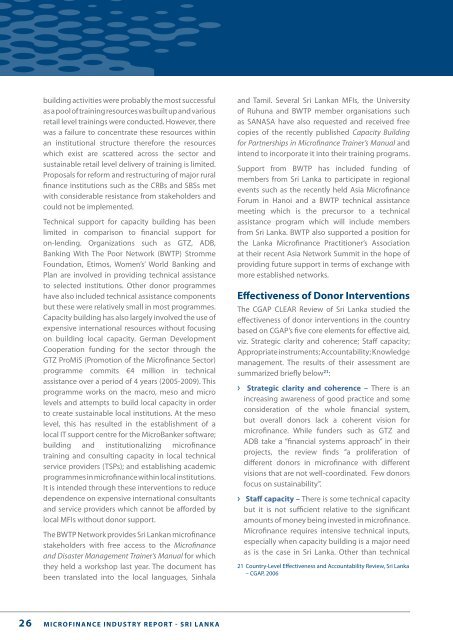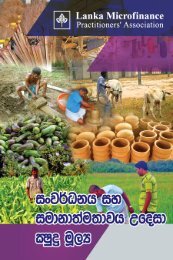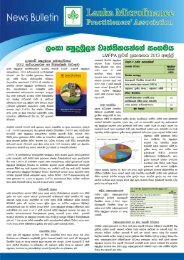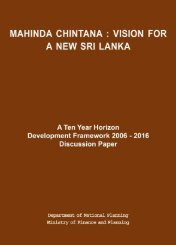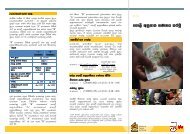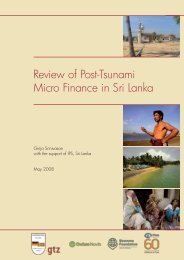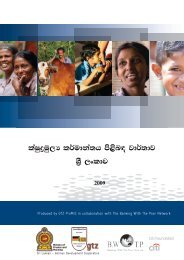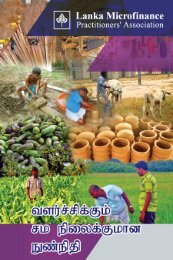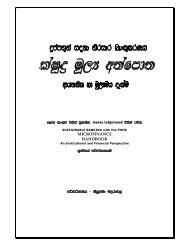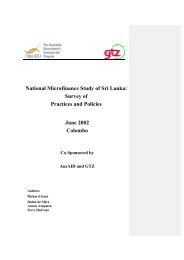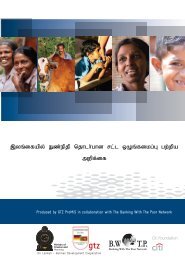Microfinance Industry Report SRI LANKA - Microfinance in Sri Lanka
Microfinance Industry Report SRI LANKA - Microfinance in Sri Lanka
Microfinance Industry Report SRI LANKA - Microfinance in Sri Lanka
You also want an ePaper? Increase the reach of your titles
YUMPU automatically turns print PDFs into web optimized ePapers that Google loves.
uild<strong>in</strong>g activities were probably the most successful<br />
as a pool of tra<strong>in</strong><strong>in</strong>g resources was built up and various<br />
retail level tra<strong>in</strong><strong>in</strong>gs were conducted. However, there<br />
was a failure to concentrate these resources with<strong>in</strong><br />
an <strong>in</strong>stitutional structure therefore the resources<br />
which exist are scattered across the sector and<br />
susta<strong>in</strong>able retail level delivery of tra<strong>in</strong><strong>in</strong>g is limited.<br />
Proposals for reform and restructur<strong>in</strong>g of major rural<br />
f<strong>in</strong>ance <strong>in</strong>stitutions such as the CRBs and SBSs met<br />
with considerable resistance from stakeholders and<br />
could not be implemented.<br />
Technical support for capacity build<strong>in</strong>g has been<br />
limited <strong>in</strong> comparison to f<strong>in</strong>ancial support for<br />
on-lend<strong>in</strong>g. Organizations such as GTZ, ADB,<br />
Bank<strong>in</strong>g With The Poor Network (BWTP) Stromme<br />
Foundation, Etimos, Women’s’ World Bank<strong>in</strong>g and<br />
Plan are <strong>in</strong>volved <strong>in</strong> provid<strong>in</strong>g technical assistance<br />
to selected <strong>in</strong>stitutions. Other donor programmes<br />
have also <strong>in</strong>cluded technical assistance components<br />
but these were relatively small <strong>in</strong> most programmes.<br />
Capacity build<strong>in</strong>g has also largely <strong>in</strong>volved the use of<br />
expensive <strong>in</strong>ternational resources without focus<strong>in</strong>g<br />
on build<strong>in</strong>g local capacity. German Development<br />
Cooperation fund<strong>in</strong>g for the sector through the<br />
GTZ ProMiS (Promotion of the <strong>Microf<strong>in</strong>ance</strong> Sector)<br />
programme commits €4 million <strong>in</strong> technical<br />
assistance over a period of 4 years (2005-2009). This<br />
programme works on the macro, meso and micro<br />
levels and attempts to build local capacity <strong>in</strong> order<br />
to create susta<strong>in</strong>able local <strong>in</strong>stitutions. At the meso<br />
level, this has resulted <strong>in</strong> the establishment of a<br />
local IT support centre for the MicroBanker software;<br />
build<strong>in</strong>g and <strong>in</strong>stitutionaliz<strong>in</strong>g microf<strong>in</strong>ance<br />
tra<strong>in</strong><strong>in</strong>g and consult<strong>in</strong>g capacity <strong>in</strong> local technical<br />
service providers (TSPs); and establish<strong>in</strong>g academic<br />
programmes <strong>in</strong> microf<strong>in</strong>ance with<strong>in</strong> local <strong>in</strong>stitutions.<br />
It is <strong>in</strong>tended through these <strong>in</strong>terventions to reduce<br />
dependence on expensive <strong>in</strong>ternational consultants<br />
and service providers which cannot be afforded by<br />
local MFIs without donor support.<br />
The BWTP Network provides <strong>Sri</strong> <strong>Lanka</strong>n microf<strong>in</strong>ance<br />
stakeholders with free access to the <strong>Microf<strong>in</strong>ance</strong><br />
and Disaster Management Tra<strong>in</strong>er’s Manual for which<br />
they held a workshop last year. The document has<br />
been translated <strong>in</strong>to the local languages, S<strong>in</strong>hala<br />
and Tamil. Several <strong>Sri</strong> <strong>Lanka</strong>n MFIs, the University<br />
of Ruhuna and BWTP member organisations such<br />
as SANASA have also requested and received free<br />
copies of the recently published Capacity Build<strong>in</strong>g<br />
for Partnerships <strong>in</strong> <strong>Microf<strong>in</strong>ance</strong> Tra<strong>in</strong>er’s Manual and<br />
<strong>in</strong>tend to <strong>in</strong>corporate it <strong>in</strong>to their tra<strong>in</strong><strong>in</strong>g programs.<br />
Support from BWTP has <strong>in</strong>cluded fund<strong>in</strong>g of<br />
members from <strong>Sri</strong> <strong>Lanka</strong> to participate <strong>in</strong> regional<br />
events such as the recently held Asia <strong>Microf<strong>in</strong>ance</strong><br />
Forum <strong>in</strong> Hanoi and a BWTP technical assistance<br />
meet<strong>in</strong>g which is the precursor to a technical<br />
assistance program which will <strong>in</strong>clude members<br />
from <strong>Sri</strong> <strong>Lanka</strong>. BWTP also supported a position for<br />
the <strong>Lanka</strong> <strong>Microf<strong>in</strong>ance</strong> Practitioner’s Association<br />
at their recent Asia Network Summit <strong>in</strong> the hope of<br />
provid<strong>in</strong>g future support <strong>in</strong> terms of exchange with<br />
more established networks.<br />
Effectiveness of Donor Interventions<br />
The CGAP CLEAR Review of <strong>Sri</strong> <strong>Lanka</strong> studied the<br />
effectiveness of donor <strong>in</strong>terventions <strong>in</strong> the country<br />
based on CGAP’s five core elements for effective aid,<br />
viz. Strategic clarity and coherence; Staff capacity;<br />
Appropriate <strong>in</strong>struments; Accountability; Knowledge<br />
management. The results of their assessment are<br />
summarized briefly below 21 :<br />
> > Strategic clarity and coherence – There is an<br />
<strong>in</strong>creas<strong>in</strong>g awareness of good practice and some<br />
consideration of the whole f<strong>in</strong>ancial system,<br />
but overall donors lack a coherent vision for<br />
microf<strong>in</strong>ance. While funders such as GTZ and<br />
ADB take a “f<strong>in</strong>ancial systems approach” <strong>in</strong> their<br />
projects, the review f<strong>in</strong>ds “a proliferation of<br />
different donors <strong>in</strong> microf<strong>in</strong>ance with different<br />
visions that are not well-coord<strong>in</strong>ated. Few donors<br />
focus on susta<strong>in</strong>ability”.<br />
> > Staff capacity – There is some technical capacity<br />
but it is not sufficient relative to the significant<br />
amounts of money be<strong>in</strong>g <strong>in</strong>vested <strong>in</strong> microf<strong>in</strong>ance.<br />
<strong>Microf<strong>in</strong>ance</strong> requires <strong>in</strong>tensive technical <strong>in</strong>puts,<br />
especially when capacity build<strong>in</strong>g is a major need<br />
as is the case <strong>in</strong> <strong>Sri</strong> <strong>Lanka</strong>. Other than technical<br />
21 Country-Level Effectiveness and Accountability Review, <strong>Sri</strong> <strong>Lanka</strong><br />
– CGAP, 2006<br />
26 microf<strong>in</strong>ance <strong>in</strong>dustry report - <strong>SRI</strong> <strong>LANKA</strong>


